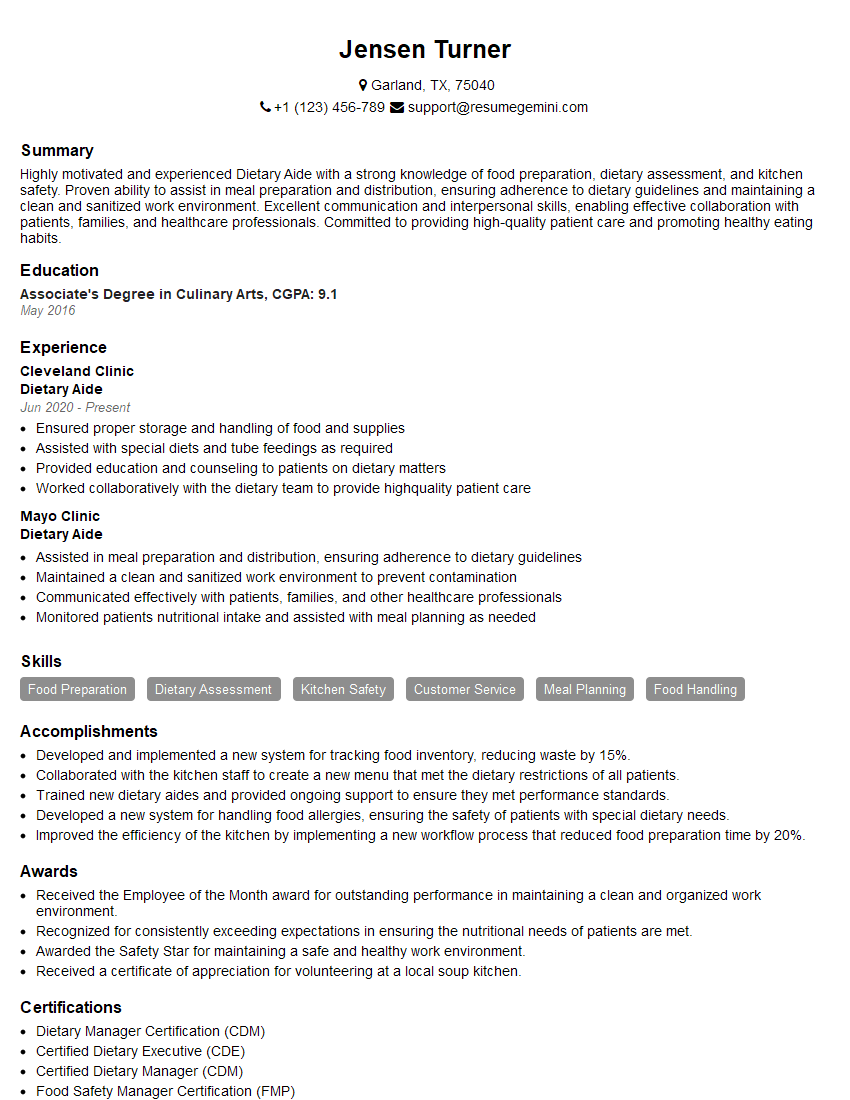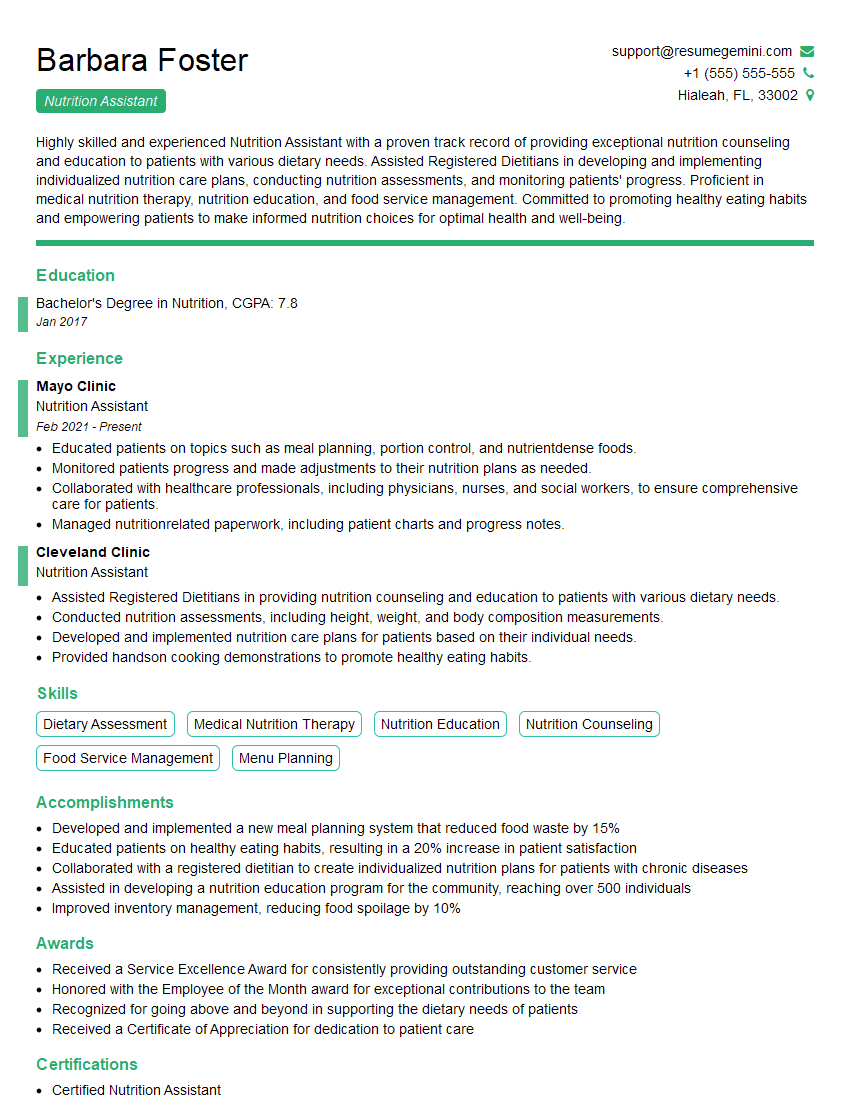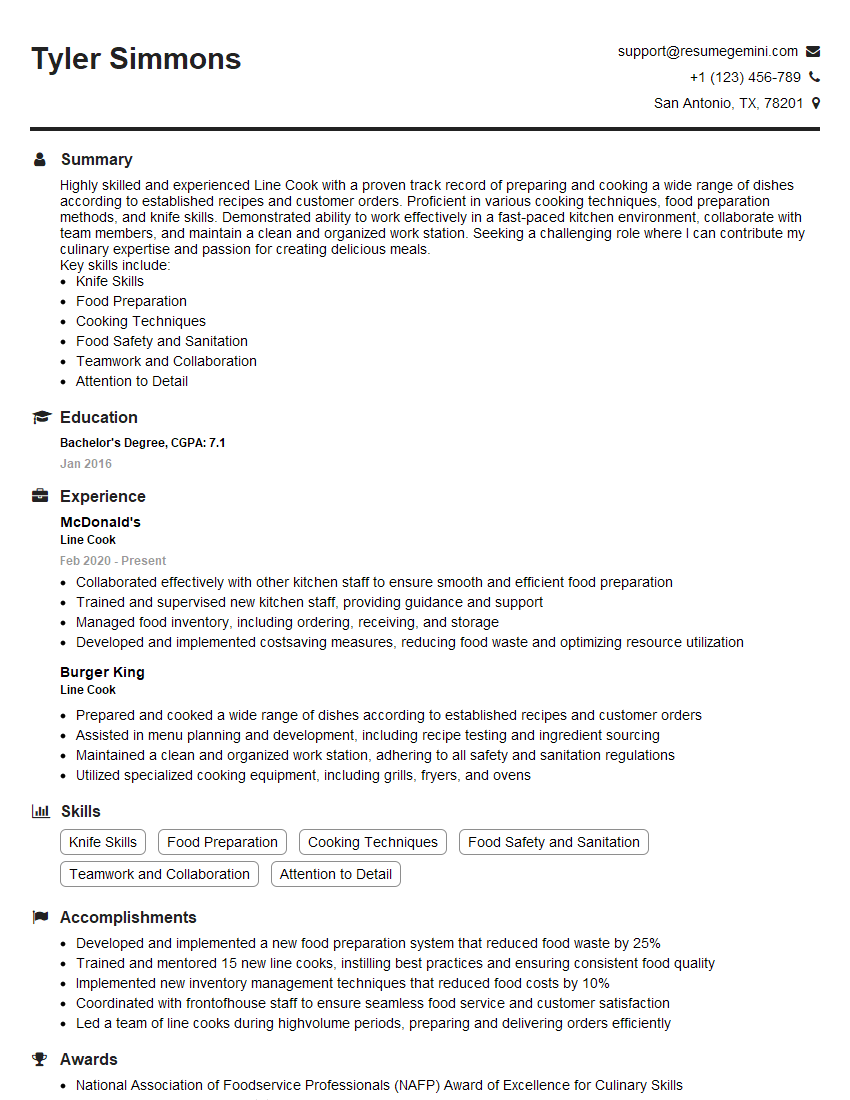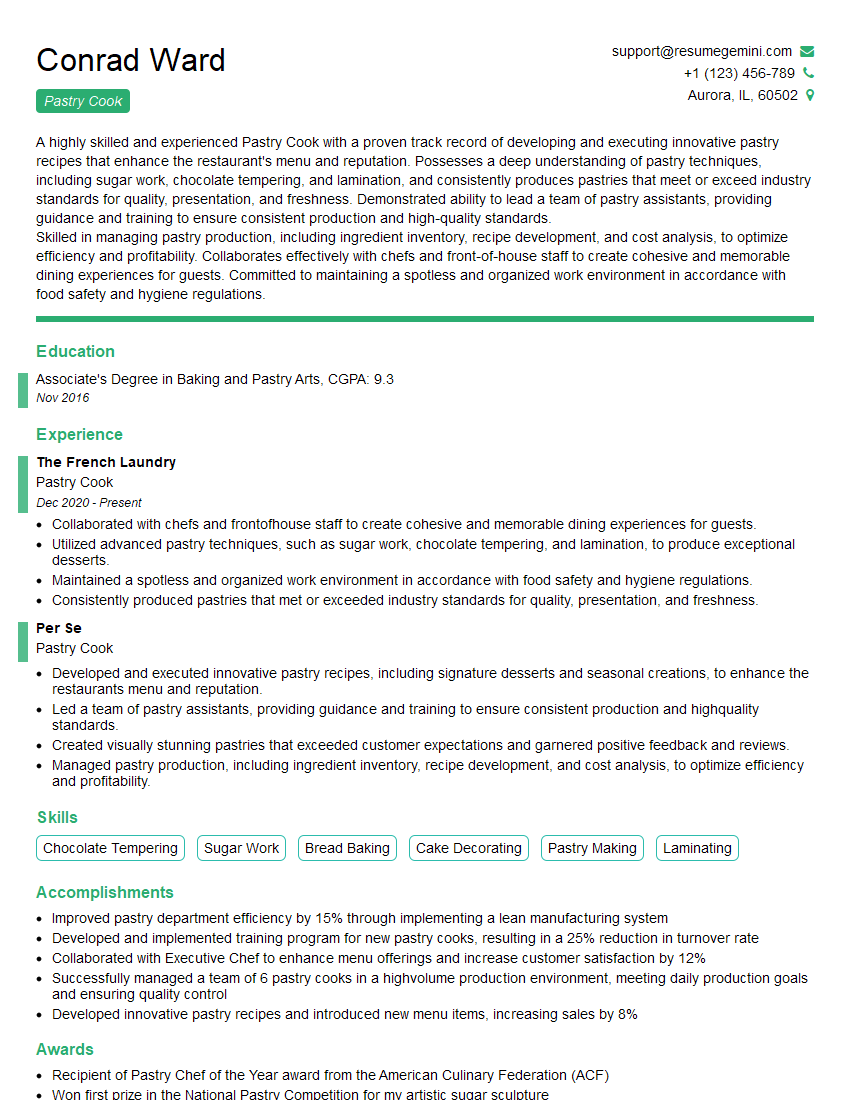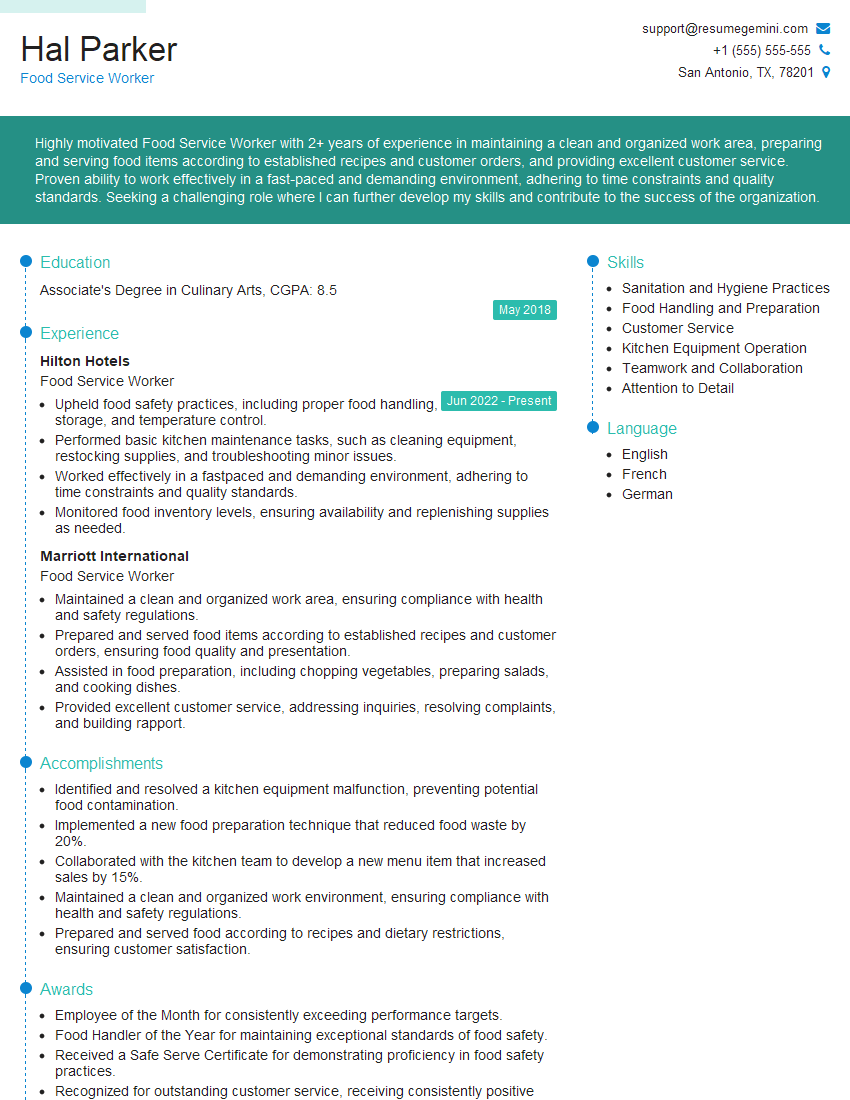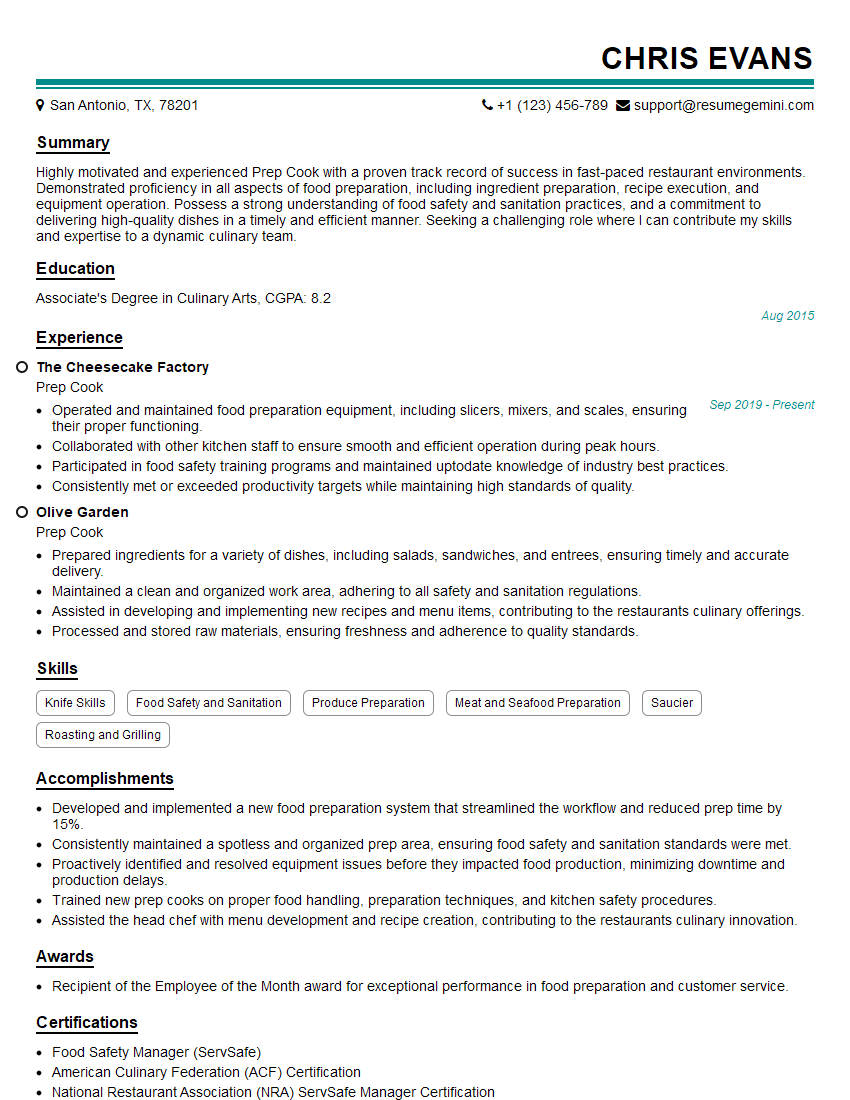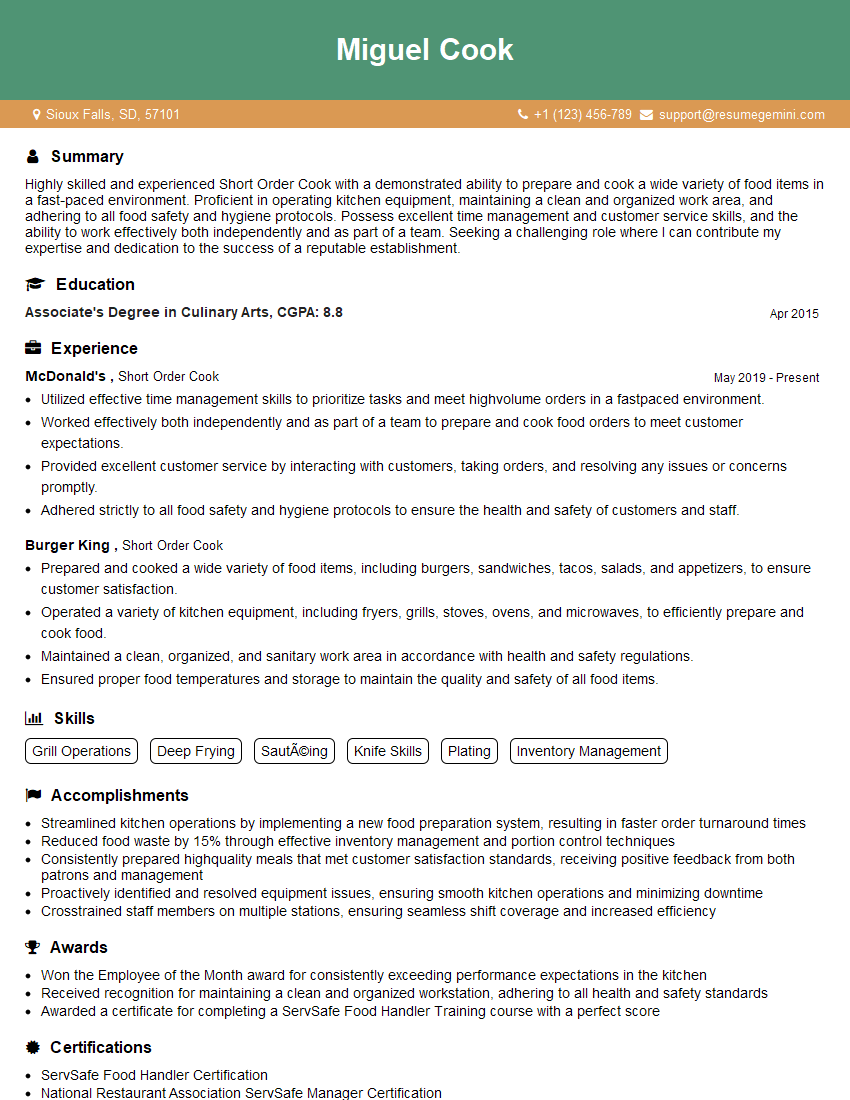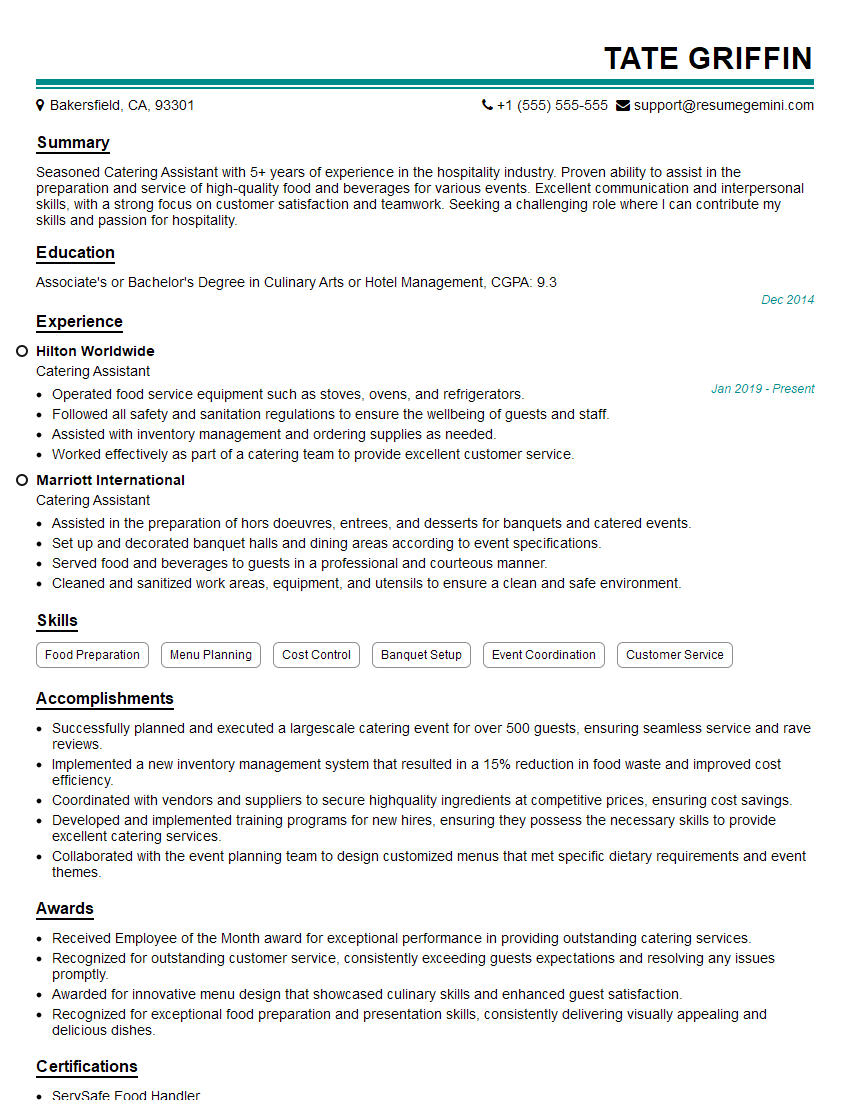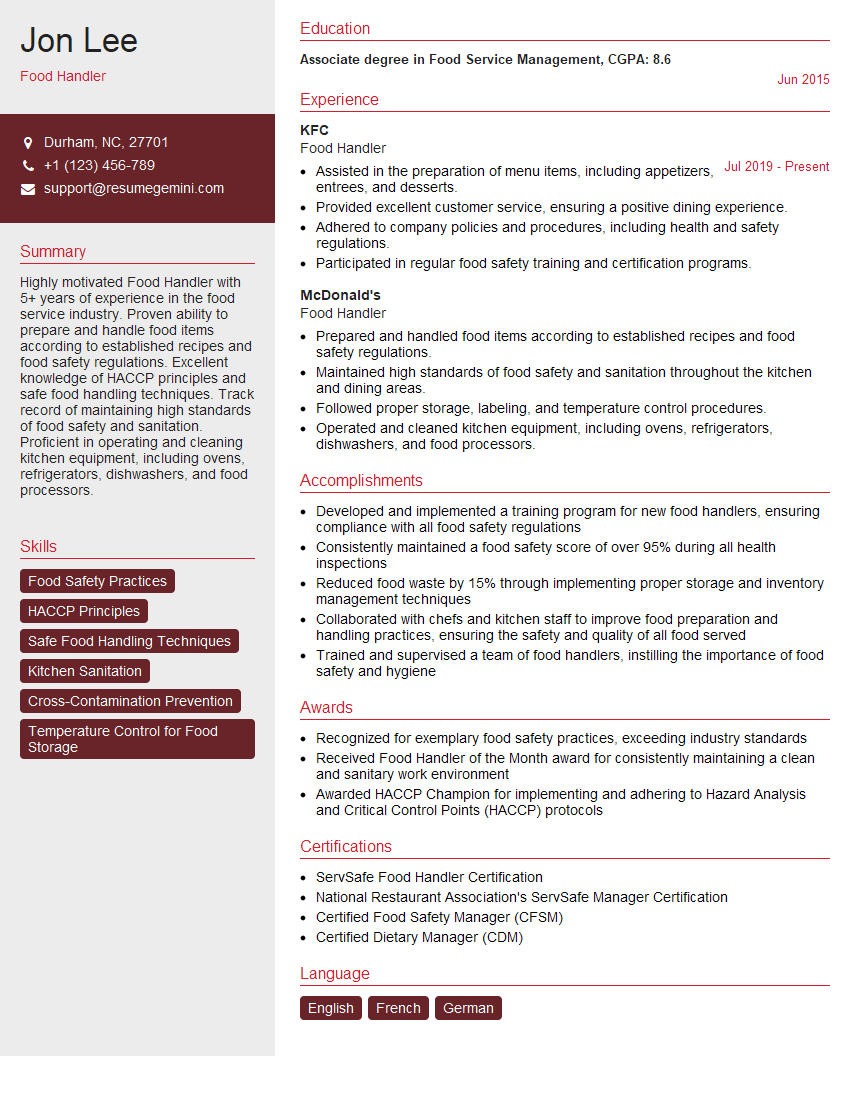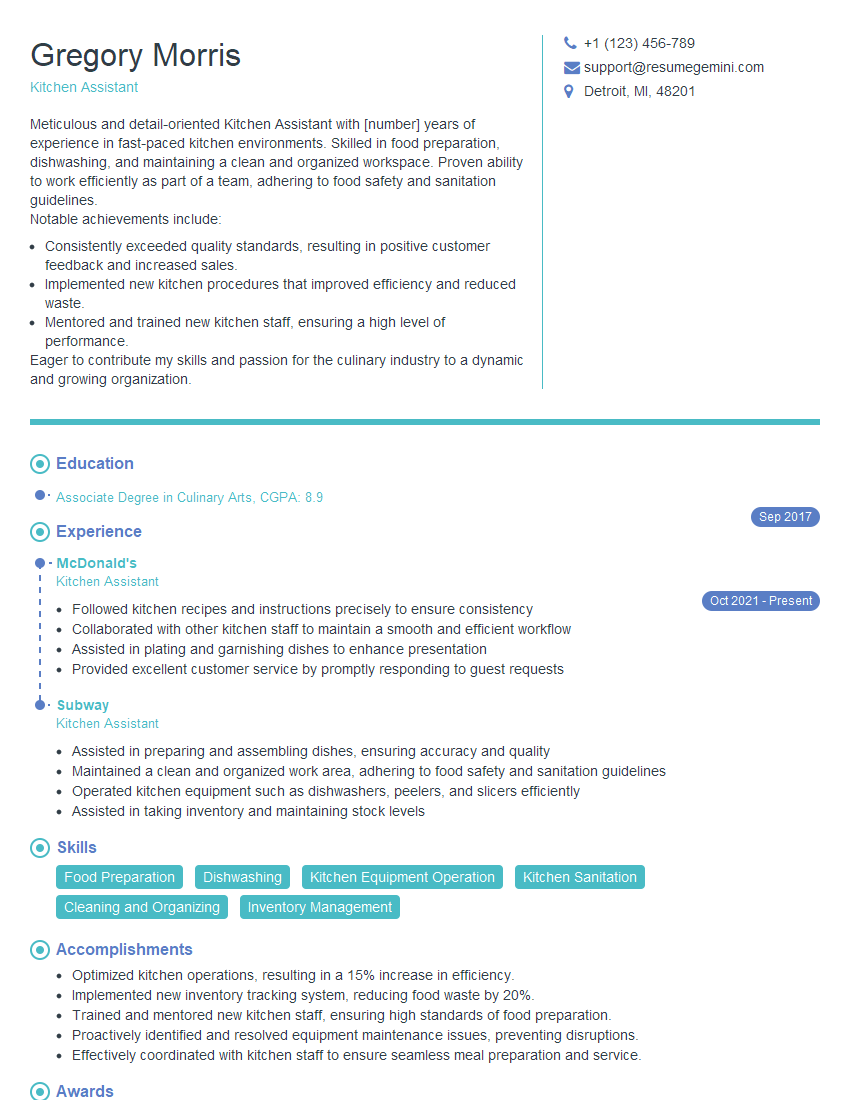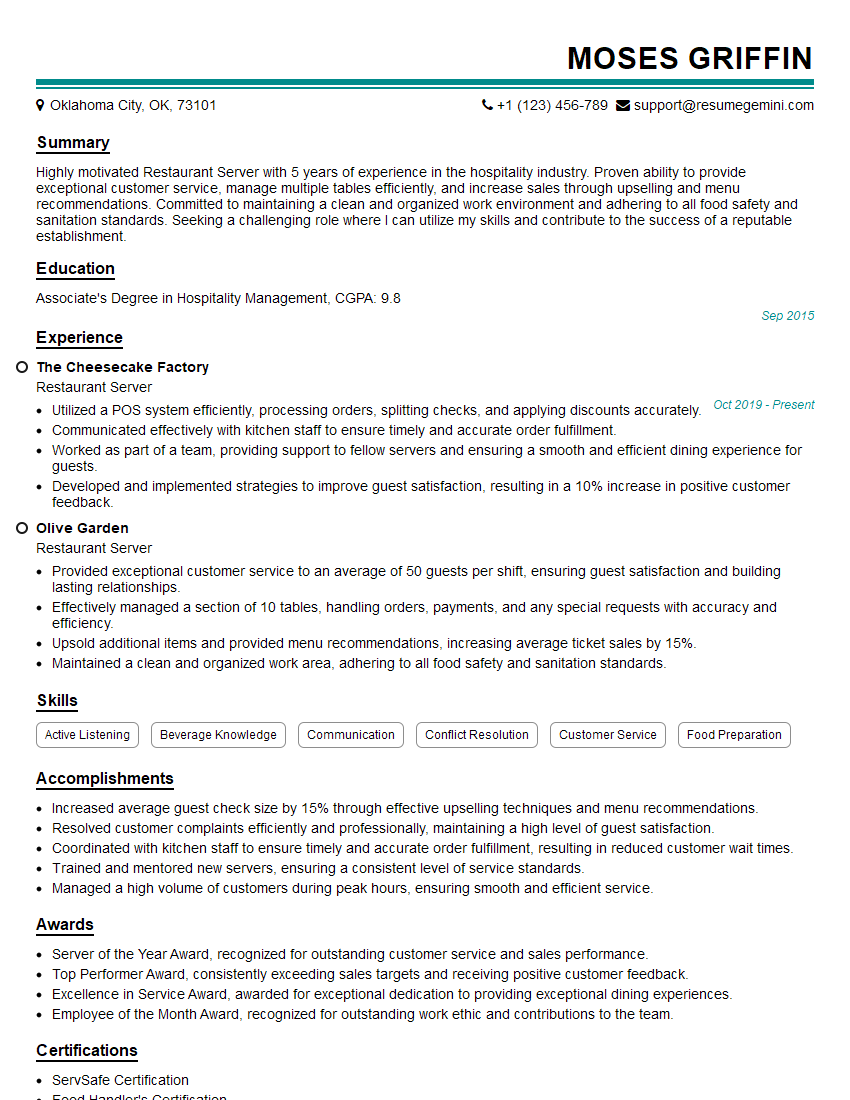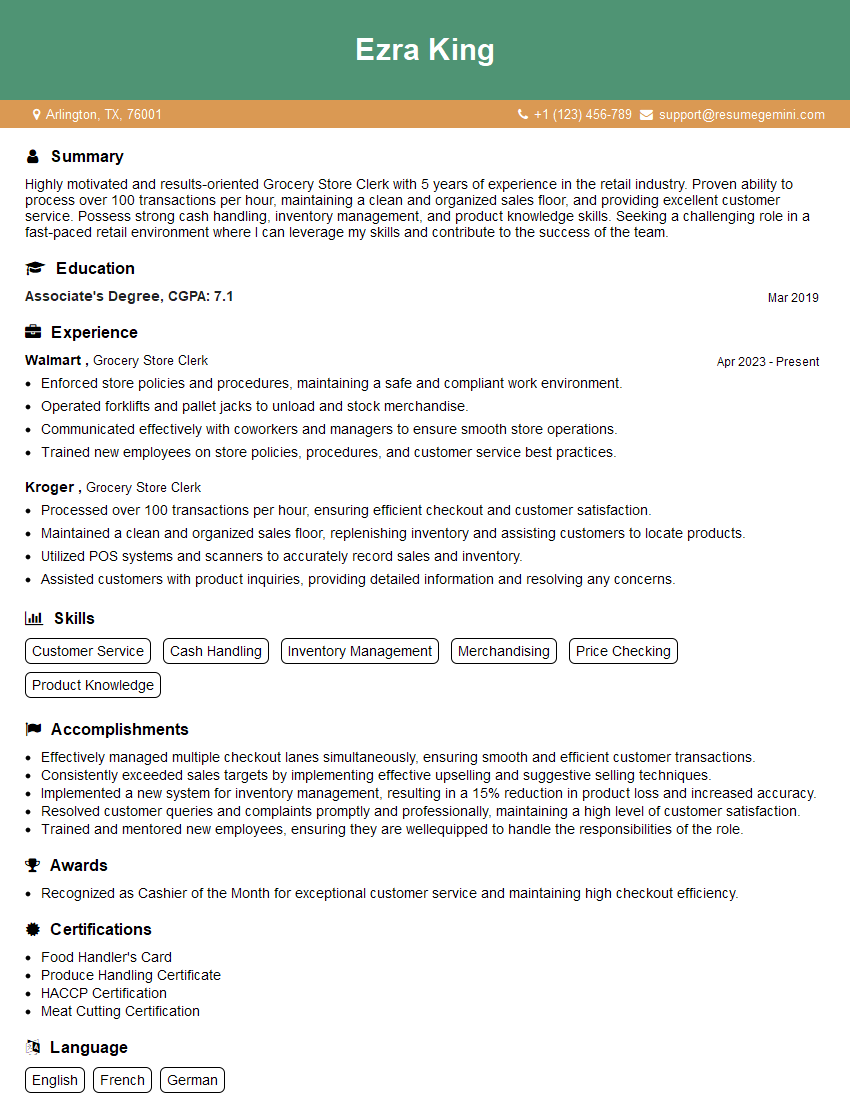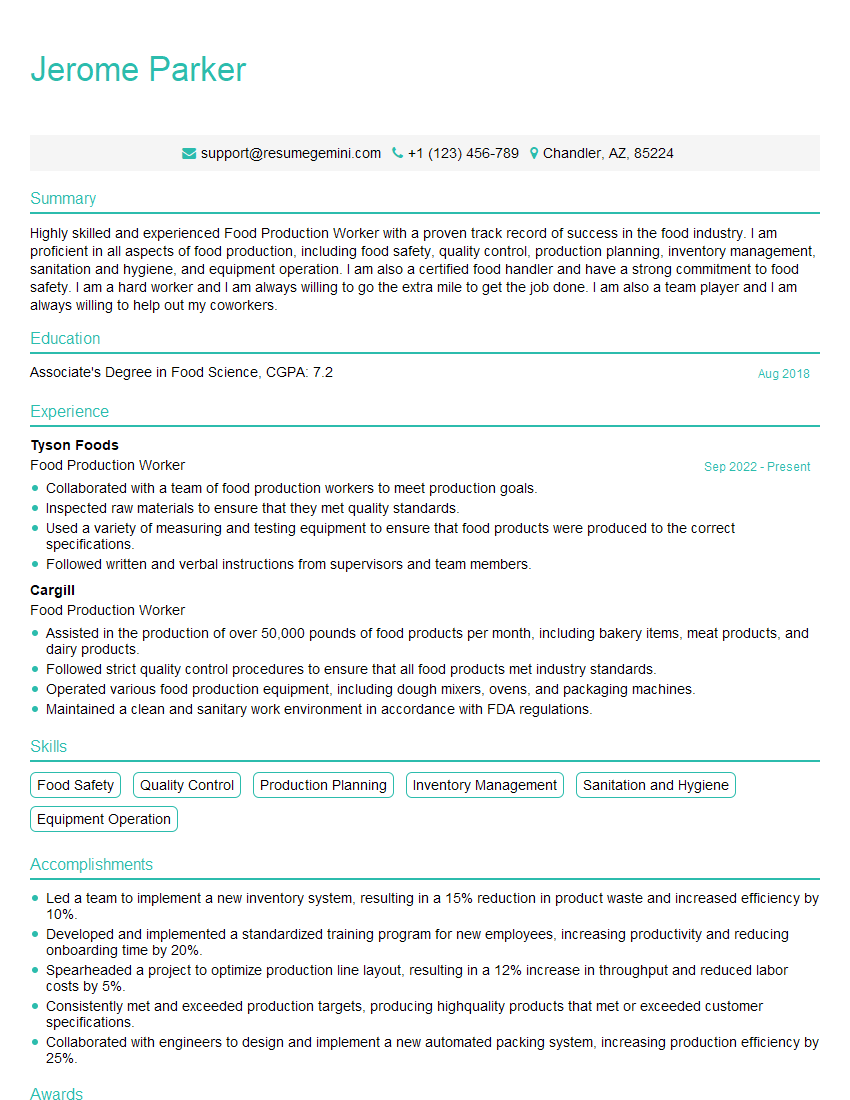Cracking a skill-specific interview, like one for Basic Food Knowledge, requires understanding the nuances of the role. In this blog, we present the questions you’re most likely to encounter, along with insights into how to answer them effectively. Let’s ensure you’re ready to make a strong impression.
Questions Asked in Basic Food Knowledge Interview
Q 1. What are the five key principles of food safety?
Food safety hinges on five crucial principles designed to minimize the risk of foodborne illnesses. Think of them as the cornerstones of a safe kitchen.
- Keep it clean: Wash your hands, surfaces, and equipment frequently. Imagine a chef meticulously cleaning their workspace before starting a delicate dish – that’s the level of cleanliness required.
- Separate raw and cooked: Never let raw meat, poultry, or seafood touch ready-to-eat foods. Picture a color-coded cutting board system: red for raw, green for vegetables, blue for fish. This prevents cross-contamination.
- Cook thoroughly: Use a food thermometer to ensure that foods reach safe internal temperatures. Undercooked chicken is a recipe for disaster. A thermometer gives you the certainty that it’s safe.
- Keep food at safe temperatures: Refrigerate promptly to prevent bacterial growth. Leaving leftovers at room temperature for even a few hours can drastically increase the risk of food poisoning.
- Use safe water and raw materials: Start with clean ingredients and water. Selecting fresh, high-quality produce and using clean water for washing and cooking ensures a safe foundation.
Q 2. Explain the temperature danger zone for food.
The temperature danger zone is the range where bacteria multiply rapidly, increasing the risk of foodborne illness. This critical range is between 40°F (4°C) and 140°F (60°C). Think of it as the ‘danger zone’ where bacteria thrive. Foods left in this range for more than two hours should be discarded. Imagine leaving a delicious stew out on a picnic table on a warm day – it rapidly enters the danger zone!
Q 3. Describe proper handwashing techniques.
Proper handwashing is paramount. It’s the simplest yet most effective way to prevent the spread of germs. The process should be thorough and consistent.
- Wet your hands with clean, running water (warm or cold).
- Apply soap and lather well, rubbing your hands together vigorously for at least 20 seconds. Cover all surfaces, including the backs of your hands, between your fingers, and under your nails.
- Rinse your hands thoroughly under clean, running water.
- Dry your hands using a clean towel or air dryer.
Think of it like this: you’re washing away invisible enemies, preventing them from contaminating food.
Q 4. How do you prevent cross-contamination?
Cross-contamination occurs when harmful bacteria from one food transfer to another. Preventing this involves several key steps.
- Separate cutting boards: Use separate cutting boards for raw meat, poultry, seafood, and produce.
- Wash utensils thoroughly: Wash and sanitize knives, cutting boards, and other utensils after each use, especially when handling raw foods.
- Avoid cross-contact: Keep raw and cooked foods separate during storage and preparation.
- Clean surfaces: Wipe down countertops and other surfaces with a sanitizing solution after preparing raw foods.
Imagine a chef preparing a salad alongside raw chicken – that’s a recipe for disaster! Proper separation and cleaning are key.
Q 5. What are the common signs of food spoilage?
Recognizing spoilage is vital to prevent foodborne illnesses. There are several visual, olfactory, and textural indicators.
- Unpleasant odor: Sour, rancid, or off-putting smells are clear signs of spoilage.
- Changes in appearance: Mold growth, discoloration, slimy texture, or unusual spots are warning signs.
- Changes in texture: Foods that are unusually soft, mushy, or sticky are likely spoiled.
- Off-flavors: Any unexpected or unpleasant taste indicates spoilage.
Think of that slightly fuzzy piece of cheese or milk that smells oddly sour – it’s best to err on the side of caution and throw it away.
Q 6. Explain FIFO and its importance in food storage.
FIFO stands for ‘First-In, First-Out’. This is a crucial inventory management method ensuring that older food items are used before newer ones. This prevents waste and reduces the risk of spoilage.
In practice, imagine your refrigerator. You place the newly purchased milk at the back and the older milk at the front, ensuring that the older milk gets used first. This simple strategy reduces waste and minimizes food spoilage.
Q 7. What are the different methods of cooking?
Numerous cooking methods exist, each imparting unique flavors and textures. Some popular methods include:
- Baking: Cooking in a dry heat oven, ideal for cakes, breads, and roasted vegetables.
- Boiling: Submerging food in boiling water, suitable for pasta, vegetables, and eggs.
- Steaming: Cooking with steam, preserving nutrients and producing tender results – think of perfectly steamed asparagus.
- Frying: Cooking in hot oil, resulting in crispy exteriors and tender interiors. Think French fries!
- Grilling: Cooking over direct heat, imparting smoky flavor – perfect for burgers and steaks.
- Sautéing: Cooking in a small amount of fat over moderate heat, ideal for quick cooking of vegetables and meats.
- Roasting: Cooking in an oven using dry heat at a relatively high temperature – good for meats and vegetables.
Each method offers unique advantages, allowing for creative culinary exploration.
Q 8. Describe the difference between blanching and parboiling.
Blanching and parboiling are both cooking techniques that involve partially cooking food in boiling water, but they differ significantly in their duration and purpose.
Blanching is a quick dip in boiling water, typically lasting only a few seconds to a couple of minutes. It’s used to briefly soften vegetables, making them easier to peel or to stop enzyme activity which can lead to discoloration and loss of nutrients. Think of it as a gentle shock treatment. For example, blanching green beans before freezing helps preserve their vibrant color and crispness.
Parboiling, on the other hand, involves a longer simmering process in boiling water. It partially cooks the food, often until it’s slightly tender. Parboiling is frequently used to prepare foods for further cooking. For instance, parboiling potatoes before roasting helps them cook evenly and reduces the overall cooking time. It can also be used to reduce bitterness in certain vegetables.
The key difference lies in the time: a quick plunge for blanching versus a longer simmer for parboiling.
Q 9. What are some common knife cuts and their uses?
Knife cuts are essential for achieving consistent cooking results and enhancing the visual appeal of dishes. Different cuts offer varied cooking times and textures.
- Dice: Small, uniform cubes (e.g., 1/4 inch, 1/2 inch). Excellent for even cooking in stir-fries or soups.
- Mincing: Finely chopping into very small pieces. Ideal for aromatic ingredients in sauces or rubs.
- Julienne: Thin matchsticks (about 1/8 inch thick). Perfect for garnishes or stir-fries, providing a delicate texture.
- Brunoise: Tiny cubes, even smaller than dice (about 1/8 inch). Used for creating delicate textures in sauces or as a garnish.
- Chiffonade: Thinly sliced leafy greens, like basil or spinach. Adds a beautiful visual element to salads or soups.
- Chop: Irregularly shaped pieces, varying in size. A quick and versatile cut for many applications.
Choosing the right knife cut depends entirely on the recipe and desired texture. For example, a large dice is suitable for potatoes in a stew, while a brunoise would be perfect for a mirepoix (a classic aromatic base for many sauces).
Q 10. How do you properly measure ingredients?
Accurate measuring is crucial for consistent baking and cooking results. Using the right tools and techniques ensures that your recipes turn out as expected.
- Dry Ingredients (flour, sugar, etc.): Use a dry measuring cup. Lightly spoon the ingredient into the cup, avoiding packing it down. Level off the top with a straight edge for an accurate measurement.
- Liquid Ingredients (milk, oil, etc.): Use a liquid measuring cup. Place the cup on a flat surface and pour the liquid slowly until you reach the desired level. Look at eye level to ensure precision.
- Weight Measurement: For the most accurate measurements, especially in baking, use a kitchen scale. Weight is consistent regardless of temperature or humidity, unlike volume measurements.
For example, if you’re baking a cake, using a kitchen scale to weigh your flour will yield a more consistent result than using a volume measurement, as packing the flour into a cup will change the final measurement significantly.
Q 11. What are some common herbs and spices and their uses?
Herbs and spices are fundamental to cooking, adding flavor, aroma, and visual appeal to dishes. They are also often beneficial to health.
- Basil: Sweet, slightly peppery flavor. Commonly paired with tomato-based dishes, pesto, or caprese salad.
- Oregano: Earthy, pungent flavor. A staple in Italian and Mediterranean cuisine, often used in pizzas and pasta sauces.
- Rosemary: Woodsy, slightly piney flavor. Pairs well with roasted meats, poultry, and potatoes.
- Cumin: Warm, earthy flavor. A key ingredient in Mexican, Indian, and Middle Eastern dishes.
- Cinnamon: Sweet, warm flavor. Used in baked goods, desserts, and savory dishes.
- Garlic Powder: Adds a potent garlic flavor without the need for fresh garlic. Useful in many savory dishes.
Experimentation is key. Try different combinations to find your preferred flavor profiles! Remember, a little goes a long way, particularly with spices.
Q 12. Explain the difference between different types of flour.
Different types of flour vary in protein content, which affects their gluten development. Gluten is a protein that creates the structure in baked goods.
- All-Purpose Flour: A medium-protein flour, suitable for a wide range of baking applications. It provides a good balance of structure and tenderness.
- Bread Flour: High-protein flour, ideal for bread making. The high protein content results in strong gluten development, creating chewy, well-risen loaves.
- Cake Flour: Low-protein flour, best for cakes and delicate pastries. The low protein content creates a tender crumb.
- Whole Wheat Flour: Made from the entire wheat kernel, including the bran and germ. It adds nutty flavor and fiber to baked goods but results in a denser crumb than white flour.
The type of flour you choose significantly influences the outcome of your baking. For instance, using bread flour to make a delicate cake would result in a tough and dense cake, while using cake flour to make bread would lead to a crumbly and shapeless loaf.
Q 13. What is the proper way to store different types of produce?
Proper storage of produce significantly extends its shelf life and maintains its freshness, flavor, and nutritional value.
- Fruits and Vegetables: Store most fruits and vegetables in the refrigerator, ideally in the crisper drawers. Some exceptions include potatoes and onions, which should be stored in a cool, dark, and dry place.
- Leafy Greens: Wrap leafy greens in paper towels and store them in a plastic bag in the refrigerator crisper drawer. This helps maintain moisture and prevent wilting.
- Herbs: Place fresh herbs in a glass of water, similar to flowers, to help them stay fresh longer. Alternatively, wrap them in a damp paper towel and store them in a sealed bag in the refrigerator.
- Bananas: Store bananas separately from other fruits as they release ethylene gas, which can accelerate the ripening process of other produce.
Always inspect your produce for any signs of spoilage before storing it. Removing bruised or damaged areas can help to prevent rot from spreading to other parts of the produce.
Q 14. How do you safely thaw frozen food?
Thawing frozen food safely is essential to prevent the growth of harmful bacteria and ensure food quality.
- Refrigerator Thawing: The safest method. Transfer frozen food from its packaging to a container or plate and place it in the refrigerator. Allow ample time for thawing—this can vary significantly depending on the size and type of food.
- Cold Water Thawing: Place the food in a leak-proof bag and submerge it in cold water. Change the water every 30 minutes to maintain a consistent cold temperature. This method is faster than refrigerator thawing but requires more attention.
- Microwave Thawing: Some microwaves have a defrost setting. This is often convenient but can result in uneven thawing, and some parts of the food may start cooking before others. Use this cautiously.
- Never thaw food at room temperature: This allows bacteria to multiply rapidly, posing a significant food safety risk.
Always cook food thoroughly immediately after thawing. Never refreeze food once it has been thawed.
Q 15. What are some common food allergens?
Common food allergens are substances that trigger an immune response in susceptible individuals. They vary in prevalence and severity, but the most frequent culprits include:
- Milk: Cow’s milk is a major allergen, affecting proteins like casein and whey.
- Eggs: Egg whites and yolks both contain allergenic proteins.
- Peanuts: One of the most potent allergens, even trace amounts can cause severe reactions.
- Tree nuts (e.g., almonds, walnuts, cashews): These share similar allergenic proteins and often cause cross-reactivity.
- Soy: Found in many processed foods, soy proteins can trigger allergic reactions.
- Wheat: Gluten, a protein in wheat, is a common allergen causing celiac disease and other sensitivities.
- Fish: Various fish species contain allergenic proteins that can trigger reactions.
- Shellfish (e.g., shrimp, crab, lobster): Another potent allergen group, often causing severe reactions.
It’s crucial to remember that reactions can range from mild (itching, hives) to severe (anaphylaxis, requiring immediate medical attention).
Career Expert Tips:
- Ace those interviews! Prepare effectively by reviewing the Top 50 Most Common Interview Questions on ResumeGemini.
- Navigate your job search with confidence! Explore a wide range of Career Tips on ResumeGemini. Learn about common challenges and recommendations to overcome them.
- Craft the perfect resume! Master the Art of Resume Writing with ResumeGemini’s guide. Showcase your unique qualifications and achievements effectively.
- Don’t miss out on holiday savings! Build your dream resume with ResumeGemini’s ATS optimized templates.
Q 16. How do you identify and handle food allergies in a food service setting?
Identifying and handling food allergies in food service requires meticulous attention to detail and adherence to strict protocols. It starts with thorough staff training on allergen awareness. This includes understanding ingredient lists, recognizing cross-contamination risks, and knowing how to handle emergency situations.
We must maintain separate preparation areas, equipment, and utensils for allergen-free foods to prevent cross-contamination. Clear labeling is essential – menu items should clearly indicate potential allergens, and all ingredients should be labelled properly in storage.
A comprehensive allergen management plan should be in place, outlining procedures for receiving, storing, preparing, and serving food to minimize risks. It’s also crucial to have a well-defined emergency response plan, including access to epinephrine auto-injectors (like EpiPens) and clear communication protocols for contacting emergency services.
For example, imagine a customer with a peanut allergy. Our staff would need to know to avoid using any peanut-containing products in their meal preparation, and to thoroughly clean all surfaces to prevent cross-contamination before preparing a peanut-free meal.
Q 17. What are the basic steps involved in making a simple recipe?
Making a simple recipe, like scrambled eggs, involves these basic steps:
- Preparation: Gather all ingredients (eggs, milk/cream, butter/oil, salt, pepper). Prepare your cooking space: ensure you have a clean cooking surface, a non-stick pan, and the necessary utensils (whisk, spatula).
- Cooking: Heat the pan over medium heat. Add butter/oil. Whisk the eggs, milk/cream, salt and pepper together in a bowl. Pour the egg mixture into the pan. Cook, stirring occasionally, until the eggs are set to your desired consistency.
- Plating and Serving: Carefully remove the scrambled eggs from the pan. Serve immediately.
These steps apply across many recipes, with variations in ingredients and techniques dependent on the specific dish.
Q 18. What are the different types of cooking oils and their uses?
Various cooking oils have distinct properties, affecting flavor and nutritional value. Some common types include:
- Olive oil: Rich in monounsaturated fats, ideal for salad dressings, sautéing, and baking. Its flavor varies greatly depending on the variety and processing (extra virgin, virgin, refined).
- Avocado oil: High in monounsaturated fats with a high smoke point, suitable for high-heat cooking like frying.
- Coconut oil: High in saturated fats, adds a distinct flavor. Best used for baking or lower-heat cooking.
- Vegetable oil (e.g., canola, sunflower, soybean): A blend of various oils, often neutral in flavor with a moderate smoke point, versatile for various cooking methods.
- Butter: Contains saturated and unsaturated fats, imparting a rich flavor. More suitable for baking and lower-heat cooking due to its lower smoke point.
Selecting the right oil depends on the cooking method and desired flavor profile. High smoke point oils are best for high-heat cooking to prevent the formation of harmful compounds.
Q 19. How do you ensure the quality and freshness of ingredients?
Ensuring ingredient quality and freshness is crucial for both food safety and optimal taste. I utilize several strategies:
- Visual Inspection: Carefully examine fruits, vegetables, and other produce for signs of damage, bruising, or discoloration. Smell for any off-putting odors.
- Check Dates: Always check expiration or “best-by” dates on packaged goods. Prioritize using older items first to reduce waste.
- Proper Storage: Store ingredients correctly according to their type. Refrigerate perishable items promptly. Freeze items that will not be used within their optimal freshness period.
- Source Selection: Choose reputable suppliers known for their quality control measures and freshness standards.
- FIFO (First-In, First-Out): Organize storage areas to ensure older items are used before newer ones, minimizing waste and preventing spoilage.
For example, if I notice a slight bruising on an apple, I would trim that area or avoid using it entirely to ensure quality.
Q 20. Describe your experience with food preparation techniques.
My experience encompasses a wide range of food preparation techniques, including:
- Basic knife skills: Dicing, mincing, julienning, and other fundamental techniques for precise ingredient preparation.
- Cooking methods: Proficient in various methods such as sautéing, roasting, grilling, braising, steaming, and deep-frying. I understand the impact of each technique on the final product.
- Baking: Experienced in baking bread, cakes, pastries, and other baked goods, understanding the crucial role of measurements and timing.
- Sauces and dressings: I can create various sauces and dressings from scratch, understanding flavor balancing and emulsion techniques.
I’ve worked extensively with diverse cuisines, adapting my techniques to different culinary styles and traditions. For instance, mastering the delicate art of making a classic French béchamel sauce required attention to detail and understanding of emulsion processes.
Q 21. How do you maintain a clean and organized work environment?
Maintaining a clean and organized work environment is paramount for food safety and efficiency. My approach includes:
- Regular Cleaning: Thorough cleaning and sanitization of all work surfaces, equipment, and utensils after each use, following established protocols.
- Organized Storage: Proper storage of ingredients, tools, and equipment to prevent clutter and ensure easy access.
- Waste Management: Efficient disposal of waste to prevent pests and maintain hygiene.
- Personal Hygiene: Maintaining strict personal hygiene practices, including handwashing, wearing clean uniforms, and avoiding touching face or hair while preparing food.
- FIFO System: Applying the FIFO method in ingredient storage to ensure freshness and prevent waste.
A clean workspace prevents cross-contamination and ensures a safe and efficient workflow. It is a reflection of professionalism and dedication to food safety.
Q 22. What are the different types of cooking equipment?
Cooking equipment spans a wide range, from basic hand tools to sophisticated appliances. Categorizing them helps us understand their functions. We can broadly classify them into:
- Heat Sources: This includes stoves (gas, electric, induction), ovens (conventional, convection, microwave), grills (charcoal, gas, electric), and even open flames.
- Cooking Vessels: Pots, pans (saucepans, frying pans, woks), baking dishes (cake pans, loaf pans, casserole dishes), and specialized cookware like pressure cookers and slow cookers all fall under this category. The material matters too – stainless steel, cast iron, non-stick, ceramic, etc., each with its own properties.
- Preparation Tools: Knives (chef’s knife, paring knife, serrated knife), cutting boards, mixing bowls, whisks, spatulas, measuring cups and spoons, and food processors are essential for prepping ingredients.
- Serving and Storage: This includes plates, bowls, serving platters, storage containers, and refrigeration units.
The choice of equipment depends on the recipe, the scale of cooking (home vs. restaurant), and personal preferences. For instance, a home cook might use a simple gas stove and a few pots and pans, while a restaurant kitchen requires a much more extensive array, including industrial-sized ovens and specialized equipment.
Q 23. How do you operate and maintain basic cooking equipment?
Operating and maintaining basic cooking equipment is crucial for safety and efficiency. Here’s a breakdown:
- Before Use: Always inspect equipment for damage. Ensure cords are not frayed (for electrical appliances), gas connections are secure (for gas stoves), and surfaces are clean.
- During Use: Follow manufacturer instructions carefully. Use appropriate heat settings to avoid burning food or damaging the equipment. For instance, using high heat on non-stick pans can ruin their surface. Be mindful of hot surfaces and use oven mitts or pot holders to prevent burns.
- After Use: Clean equipment immediately after use. This prevents food from sticking and reduces the risk of bacterial growth. Different materials require different cleaning methods; some are dishwasher-safe, while others need hand washing.
- Regular Maintenance: Regular maintenance extends the lifespan of your equipment. This might involve descaling coffee makers, cleaning the oven, sharpening knives, and lubricating moving parts (if applicable).
For example, regularly cleaning a microwave prevents food splatters from becoming burnt-on residue. Similarly, sharpening knives ensures efficient and safe food preparation, preventing accidents.
Q 24. Describe your understanding of portion control.
Portion control is the practice of measuring and regulating the amount of food consumed. It’s crucial for maintaining a healthy weight, managing food costs, and preventing food waste. It involves understanding serving sizes and using measuring tools accurately.
We can achieve portion control in several ways:
- Using measuring tools: Measuring cups and spoons are vital for accurate portioning, particularly when baking or following recipes precisely.
- Using visual cues: Knowing the size of a serving – for example, a deck of cards for a serving of meat, or a baseball for a serving of fruit – helps in visual estimation.
- Using smaller plates and bowls: This creates a psychological effect, making portions seem larger and preventing overeating.
- Planning meals in advance: Pre-planning helps control the amount of food prepared and consumed.
In a restaurant setting, portion control is critical for cost management and consistency in customer experience. Inaccurate portioning can lead to losses or customer dissatisfaction.
Q 25. How would you handle a food safety violation?
Handling a food safety violation requires immediate and decisive action. The specific steps depend on the nature of the violation, but the general approach includes:
- Identify and Contain: Immediately isolate the contaminated food to prevent further contamination. This might involve discarding the food or separating it from other items.
- Notify: Inform the relevant authorities, such as a supervisor or health inspector, depending on the context (home vs. restaurant setting). Accurate documentation of the event is crucial.
- Clean and Sanitize: Thoroughly clean and sanitize all surfaces, utensils, and equipment that may have come into contact with the contaminated food. Follow proper sanitation procedures.
- Prevent Recurrence: Identify the cause of the violation and implement measures to prevent it from happening again. This might involve reviewing food handling practices, employee training, or equipment maintenance.
- Document Everything: Keep detailed records of the incident, including the date, time, nature of the violation, steps taken, and any corrective actions implemented.
For instance, if cross-contamination occurs, immediate steps should be taken to remove the affected food, clean and sanitize all areas, and review food handling procedures.
Q 26. Explain the importance of following recipes accurately.
Following recipes accurately is fundamental to achieving consistent and successful results in cooking. Recipes are carefully formulated to balance ingredients and create specific outcomes.
The importance stems from several factors:
- Ingredient Ratios: Recipes specify exact quantities for a reason. Altering these ratios can significantly affect the taste, texture, and even safety of the final product. For example, changing the baking soda to baking powder ratio in a cake can dramatically alter its rise.
- Cooking Time and Temperature: Precise cooking times and temperatures ensure that ingredients are cooked properly, preventing undercooked or overcooked food. This is especially critical for safety reasons, particularly when working with meats and poultry.
- Consistency: Following a recipe accurately ensures that you can replicate the dish consistently. It allows others to reproduce the recipe with similar results.
- Safety: Accurate measurements and cooking procedures are essential for food safety. Incorrect procedures can lead to bacterial growth or food poisoning.
Think of a recipe as a set of instructions. Just as deviating from assembly instructions for furniture can lead to a wobbly product, changing recipe instructions can lead to an unsuccessful culinary experience.
Q 27. How do you adapt recipes for different dietary needs?
Adapting recipes for different dietary needs involves thoughtful substitutions and modifications without compromising taste or safety. This requires knowledge of nutritional values and ingredient properties.
Here are some examples:
- Vegetarian/Vegan Diets: Replace meat with plant-based protein sources like tofu, tempeh, lentils, or beans. Use vegetable broth instead of chicken or beef broth. Consider egg replacements for baking.
- Gluten-Free Diets: Replace wheat flour with gluten-free alternatives such as almond flour, rice flour, or a gluten-free blend. Ensure all other ingredients are gluten-free.
- Dairy-Free Diets: Use dairy-free milk alternatives (almond, soy, oat) and dairy-free cheese substitutes. Some recipes may require adjustments to achieve the desired texture and consistency.
- Low-Sodium Diets: Reduce or eliminate added salt, using herbs and spices to enhance flavor. Choose low-sodium ingredients when possible.
When adapting recipes, it’s important to understand the role each ingredient plays. A simple substitution may not always work, and adjustments to cooking methods or other ingredients might be necessary.
Q 28. Describe your experience working with a team in a food service setting.
In previous roles within food service, teamwork has been essential. I’ve worked in settings requiring fast-paced, coordinated efforts, whether preparing large quantities of food or serving a busy dining area.
My experience includes:
- Collaboration during food preparation: Working efficiently with other cooks to ensure timely and accurate preparation of dishes. This involves clear communication, assignment of tasks, and efficient use of workspace.
- Coordination during service: Collaborating with servers to manage food orders, ensure accurate delivery to customers, and address any issues promptly. This often involved anticipating needs and reacting quickly to changes.
- Maintaining hygiene and safety: Working together to ensure a clean and safe workspace, adhering to food safety protocols, and assisting in resolving any potential issues.
- Problem-solving as a team: Effectively addressing unexpected challenges, such as last-minute order changes or equipment malfunctions, through collaborative problem-solving.
One specific example was during a particularly busy lunch rush where one of the ovens malfunctioned. Through quick communication and collaborative effort, we successfully rerouted the affected orders to other equipment, minimizing delays and maintaining customer satisfaction. This experience demonstrated the importance of teamwork, communication, and adaptability.
Key Topics to Learn for Basic Food Knowledge Interview
- Food Safety and Hygiene: Understand principles of food safety, including proper handling, storage, and preparation techniques to prevent contamination and spoilage. Consider practical applications like HACCP principles and safe temperature zones.
- Nutrition Basics: Grasp fundamental nutritional concepts, such as macronutrients (carbohydrates, proteins, fats), micronutrients (vitamins, minerals), and their roles in maintaining health. Explore practical applications in meal planning and dietary considerations.
- Food Preservation Methods: Familiarize yourself with various preservation techniques like canning, freezing, drying, and fermentation. Understand the principles behind each method and their impact on food quality and safety.
- Food Chemistry and Sensory Evaluation: Explore basic food chemistry concepts, including the chemical composition of foods and how it affects their properties. Understand the principles of sensory evaluation, including taste, smell, texture, and appearance.
- Ingredient Functionality: Learn how different ingredients contribute to the texture, flavor, and appearance of food products. Understand the role of emulsifiers, thickeners, and leavening agents.
- Culinary Techniques and Principles: Develop a basic understanding of various cooking methods (baking, roasting, frying, etc.) and their impact on food texture, flavor, and nutritional value. Consider the practical application of different cooking methods in various culinary contexts.
- Dietary Needs and Restrictions: Gain knowledge of common dietary restrictions and needs, such as vegetarianism, veganism, allergies, and intolerances. Understand how to adapt recipes and meal plans to accommodate these needs.
Next Steps
Mastering Basic Food Knowledge is crucial for career advancement in the food industry, opening doors to diverse roles and opportunities. A well-crafted resume is your key to unlocking these prospects. To maximize your chances, focus on building an ATS-friendly resume that highlights your skills and experience effectively. ResumeGemini is a trusted resource that can help you create a professional and impactful resume tailored to your specific needs. Examples of resumes tailored to Basic Food Knowledge are available to guide you. Take advantage of these resources to present yourself as a strong candidate.
Explore more articles
Users Rating of Our Blogs
Share Your Experience
We value your feedback! Please rate our content and share your thoughts (optional).
What Readers Say About Our Blog
This was kind of a unique content I found around the specialized skills. Very helpful questions and good detailed answers.
Very Helpful blog, thank you Interviewgemini team.
